Daily urine - this is the basis for the study of all fluid that is excreted by the kidneys per day. Therefore, samples must be collected several times. The very technology of preparation of biological material is significantly different from the standard single collection in the morning.
Record content:
-
1 General recommendations
- 1.1 Patient preparation
- 1.2 Rules
- 1.3 Capacities, devices
- 2 Storage conditions at home
-
3 Features by type
- 3.1 For protein
- 3.2 For sugar
- 3.3 For cortisol
- 3.4 For calcium
- 3.5 For phosphorus
- 3.6 To oxalates
- 3.7 At UIA
- 4 Daily urine video
General recommendations
Basically, the recommendations come down to the exclusion of taking diuretics and excessive amounts of salty foods, which can significantly distort the results obtained.
Patient preparation
Daily urine, which must be collected throughout the day, including at night, requires adherence to the following recommendations:
- tea and other drinks should be consumed in the usual quantities;
- the moment of visiting the toilet with a flush is considered the beginning;
- collection of urine should be started on an empty bladder.

If the doctor recommends that each sample be provided in a separate container, it is advisable to prepare a marker nearby and additionally indicate the exact time of collection of the next portion of urine. This will allow assessing the dynamics of kidney function. Additionally, you should provide the time and volumes of liquids drunk during the day.
Rules
The basic rules are reduced to the following recommendations:
- samples will require special sterile containers from the pharmacy;
- all containers should be signed with a marker, indicating the surname and initials;
- Before each urine collection, the genitals should be thoroughly washed.
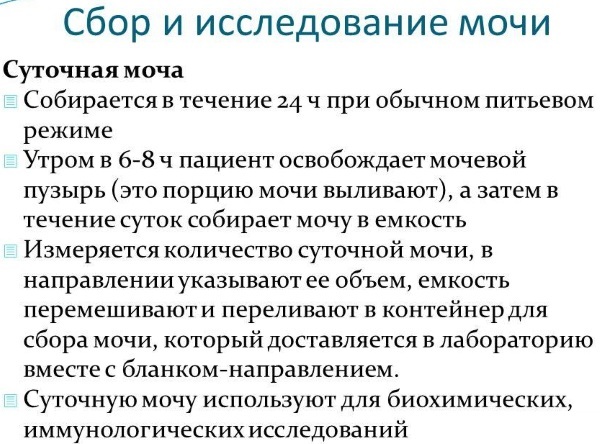
In some cases, it is allowed to collect urine in a common container, when the result is needed by the doctor in order to assess the general function of the kidneys by the production of urine. Often, such an analysis is prescribed for women during pregnancy.
At this time, especially at a later date, the body is constantly experiencing significant overload. Assessment of renal function will suggest or confirm the development of preeclampsia of one degree or another.
Another category of patients is people with serious diseases of the kidneys, urological tract, diabetics of both types and patients with deviations of a similar severity. Also, to obtain an objective result, the day before, you should not eat foods that can stain urine. Women should not collect urine samples during their period.
Capacities, devices
You do not need to bring all the urine to the laboratory. Any adequate patient should understand that the correct diagnosis will largely depend on the provision of accurate data on the released daily volume. On its basis, the doctor will be able to prescribe an effective therapy that will have a quick therapeutic effect.
Therefore, after the end of the daily collection of urine, it is necessary to mix it well and pour a small portion of about 50 ml into a separate jar. After that, it is advisable to collect information by writing down on a separate sheet of time and the amount of urine excreted.
These 2 data will be enough for research in a laboratory and a diagnosis by a doctor. Additionally, information on height and body weight can be provided.
For greater convenience, hygiene and resistance to spoilage, it is recommended to use special containers specially designed for such analysis. For example, one of the most convenient is a container for biomaterials with a total volume of up to 3 liters. At the end of the daily collection, the total quantity can be quickly estimated thanks to the applied risks, indicating the volume of each level.
Their advantages over other handy containers for home use are opacity, due to which relieves discomfort during manipulation and movement around the house, including constant contact with refrigerator. The last condition is imperative in order to slow down the process of biological deterioration of the material as much as possible.
Storage conditions at home
Long-term storage requires a cool air temperature in the refrigerator compartment. The collection process takes exactly 24 hours from start to finish.
After the end of this period, the entire volume will need to be mixed again. Then take a small amount for the laboratory. Some of them allow you to store the common container directly in the toilet, covered with a lid, without twisting too tightly.
In practice, this is not recommended in all cases where microbiological examination is required. Neglect of this condition will inevitably lead to bacterial reproduction and rapid deterioration of the collected samples. This can cause the urine to become cloudy and produce an extremely unpleasant odor.
Features by type
Usually, a doctor, issuing a referral for such an analysis, wants to make sure that there is no pathology or to receive confirmation of the alleged diagnosis. Therefore, the patient receives a specific referral for one or another type of urine examination in laboratory conditions.
For protein
A protein molecule is the main building block of almost every cell in the human body. Its size normally exceeds the filtration membranes of the renal tissues. Therefore, healthy people cannot have protein in their urine. But under the influence of various factors, membranes are partially destroyed, and molecules appear in biological fluids.
Daily urine, which must be collected in accordance with the basic recommendations, will allow to determine not only qualitative losses, but also quantitative ones. Based on the results obtained, the picture of the degree of already developed disorders will be clear almost immediately.
Most often, laboratory assistants find albumin in the urine.
Normally, they can be present in the analyzed sample in the following quantities:
- in the morning analysis - 8-33 mg / l;
- in daily urine - up to 100 mg / l.
The condition when the excess of the upper limits of the given norms is registered is called proteinuria.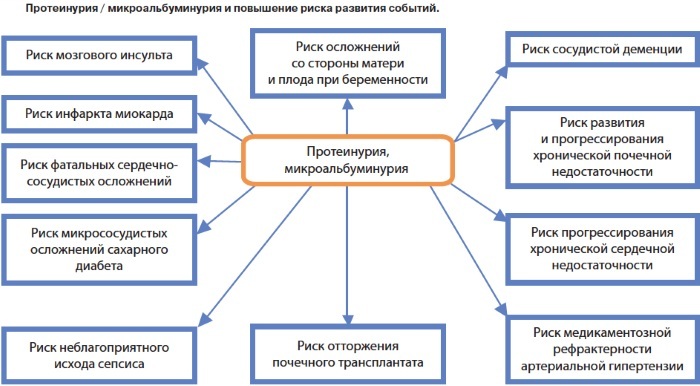
When protein appears, the patient may be referred for additional examinations to confirm or exclude the following diseases:
- bladder infections;
- diabetes;
- kidney pathology.
Especially the result of the analysis will be important for women during pregnancy. Indicators in the range of 15-20 mg / l can be detected due to the increased load on the renal blood filtration system. But even a slight excess of the specified norm is always an increase in the risk of developing severe forms of preeclampsia.
For sugar
Small amounts of glucose may be included in the urine. But with a strong increase in indicators, they already talk about glucosuria.
The following conditions become the main reasons:
- disruptions in the hormonal balance in the body;
- high level of stress loads;
- excessive doses of certain medications;
- physical overwork.
The most serious problem can be diabetes, the result of which, without timely compensation with drugs and a specific diet, often ketoacidosis develops:
- a decrease in the absorption of glucose by cells → an increase in blood sugar → the appearance of glucose in the urine → osmotic loss of fluid → dehydration → thickening of the blood → coma → death.
It is because of such a threat that the appearance of glucose in the urine should in no case be ignored, since sometimes the increase in symptoms occurs at a high rate.
In combination with the detection of glucose, other symptoms of uncompensated diabetes mellitus should be evaluated:
- violations of the sensitivity of the skin;
- dry mouth and constant thirst;
- visual impairment;
- constant use of the toilet;
- lack of physical strength;
- frequent headaches.
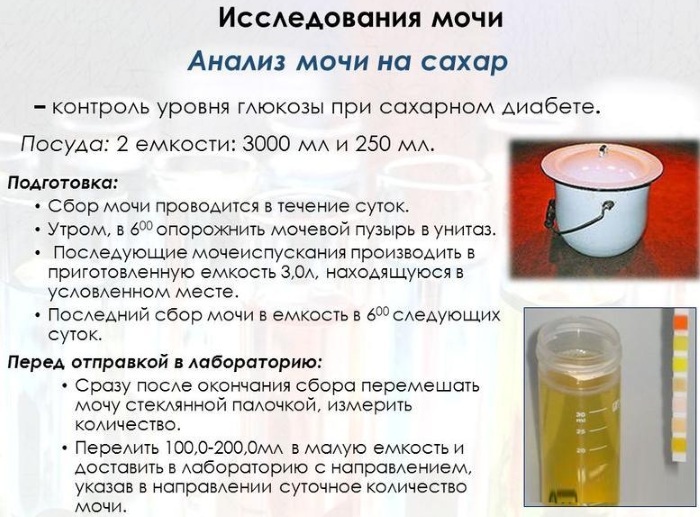
Daily urine. How to collect for sugar
For a quick assessment of the condition, it is recommended to purchase a blood glucose meter. It will allow you to estimate the amount of sugar in your blood within a few minutes. And in the absence of problems in the future, it will be able to provide invaluable assistance for the timely diagnosis of the changes that have begun and the instability of glucose levels.
At an advanced stage of the development of diabetes, a symptom is often encountered when a previously overweight person begins to rapidly lose weight. Additionally, the menstrual cycle gets lost, up to complete amenorrhea, even at reproductive age.
For cortisol
Cortisol is a hormone produced by the adrenal glands in the structure of their cortex. The main purpose is to provoke a number of signs of mobilization of the nervous systems in response to provoking factors, which include the following conditions:
- a decrease in potassium levels and an increase in calcium in the blood;
- activation of metabolism and utilization of fats;
- increased blood pressure;
- strengthening of cell membranes;
- decreased lymphocyte synthesis.
With adequate physical or mental stress, cortisol contributes to a comprehensive mobilization of the body to protect against harmful factors and, by its nature, to save life itself person.
But with a constantly elevated level in the blood, about 1% of the total amount constantly circulating in the body begins to be excreted in the urine.
The results can be consequences in the form of androgen-dependent disorders, including amenorrhea, anovulatory cycles, difficulties with conception, excess body hair growth, acne, polycystic ovary disease, hyperglycemia, increased belly fat and other unpleasant pathology.
One day before the start of the daily analysis, the following rules should be adhered to:
- exclude the use of alcoholic beverages;
- stop eating salty foods and delicacies;
- reduce the proportion of starchy foods and sweets;
- allow prolonged hunger.
The amount of water taken should be familiar. Physically, it is also recommended to stick to a normal lifestyle. Directly the process of collecting daily urine should be carried out according to the basic scheme.
For calcium
Daily urine, which can be collected for various purposes, can also reveal or confirm the development of the following pathologies:
- defects in the structure of bones, pituitary gland;
- diseases of the thyroid gland;
- rickets in young children.
Since calcium is constantly excreted from the body precisely with urine, alcoholic beverages and diuretics should be completely excluded 2 days before the collection of biomaterial for analysis.
The detected excess will allow to confirm the following diseases:
- the development of osteoporosis;
- synthesis of calcitonin;
- excess vitamin D;
- kidney disease.
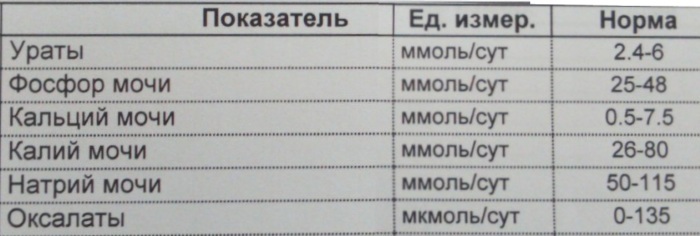
But, despite the goals of the study, such an analysis is rarely prescribed, since simpler and more accurate methods are now successfully used.
For phosphorus
Only daily urine is suitable for assessing element loss. This is due to the fact that the content of released phosphorus within 1 day varies in a wide range - ± 50%. In addition, this is influenced by the main type of food intake - carbohydrate products stimulate the redirection of phosphorus to the blood and help to reduce its level in the excreted urine.
| Patient age | Indicators are normal, daily urine volume |
| Up to 1 year | 0.6 to 15 mmol |
| 1 to 4 years old | 1 to 25 mmol |
| 4-7 years old | 10 to 30 mmol |
| 7 to 17 years old | 15 to 40 mmol |
| From 14 years old and adults | 12.9 to 42 mmol |
The diagnosed excess of the norm indicates some deviations:
- excess calciferol;
- Fanconi syndrome;
- cracks in the bones;
- acidification of the blood;
- hyperparathyroidism;
- hypophosphatemia.
Also, excessive release of phosphorus can be observed while taking certain drugs, among which are hormonal agents, hypochlorodiazide diuretics, furosemide, parathyroid hormone compounds, valine, asparagine and acid salts carbonic acid.
To oxalates
Daily urine, which the doctor prescribes to collect in order to detect oxalates, may be required to diagnose the following pathologies:
- malignant bone degeneration;
- inflammatory diseases of the gastrointestinal tract;
- metabolic disorders;
- urolithiasis disease.
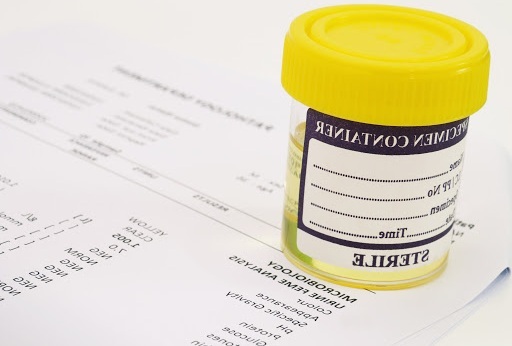
Oxalates are the common name for oxalic acid salts. At an increased content, they are able to precipitate and then crystallize. Subsequently, oxalates are deposited in the renal tissues, on the walls of the bladder and other organs of the urine excretion system. The result is the development of oxalaturia.
In a chronic form, pathology can lead to acute poisoning by the resulting compounds. The lethal dose for children, for example, is from 5 to 20 g in the total amount in the body. Death is sometimes noted for the reason that oxalates suppress normal kidney function, lead to the death of liver tissue and stimulate the development of cardiac arrhythmias.
The norms for the content of oxalates in daily urine differ somewhat depending on the age of the patient:
- up to 3 years - 0.5 mg / kg of body weight per day;
- 3-5 years - up to 12 mg / kg of body weight per day;
- from 5 years - up to 20 mg / kg per day.
To obtain a reliable result, at least 24 hours in advance, the consumption of food containing oxalates should be completely excluded:
- leafy and dark green vegetables;
- eggplant and potatoes;
- Green pepper;
- fresh herbs;
- zucchini;
- carrot;
- olives;
- salad.
This is not a complete list, so a reasonable ratio of protein and carbohydrate components in combination with fruits in the daily diet of both children and adults should be observed.
At UIA
Daily urine at UIA is a procedure performed to confirm microalbinuria, or to determine the content of albumin in it. The specified protein is always included in the blood. Its excretion in the urine to be collected indicates abnormal functioning of the renal tissues, membranes and may be a sign of the development of atherosclerotic processes.
The reasons are most often associated with significant stress on the body:
- high protein content in the daily diet;
- increased physical activity and sports;
- increased body temperature during illness.
In addition to these factors, the level of albumin in excreted urine can be influenced by the gender of the patient, his race and the area of his permanent residence.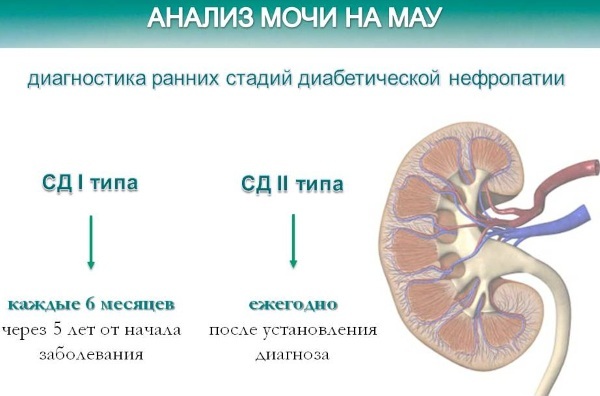
Initially, the patient does not feel any symptoms. In the future, a number of signs begin to develop, which ultimately reach the level of significant tissue edema and the cessation of renal tissue function. Then the time comes for the development of cardiac pathologies. At the same time, chest pains, an increase in the content of cholesterol in the blood begin to be regularly noted.
UIA can only collect urine in the morning. But the average sample from the daily volume will provide the most informative result. As a rule, it is no longer possible to completely restore kidney function at this stage. But timely diagnosis will allow to stabilize the patient's condition in time. In the future, it will be enough to repeat the samples no more than 1-2 times a year.
Daily urine video
Lecture on the analysis of daily urine:


